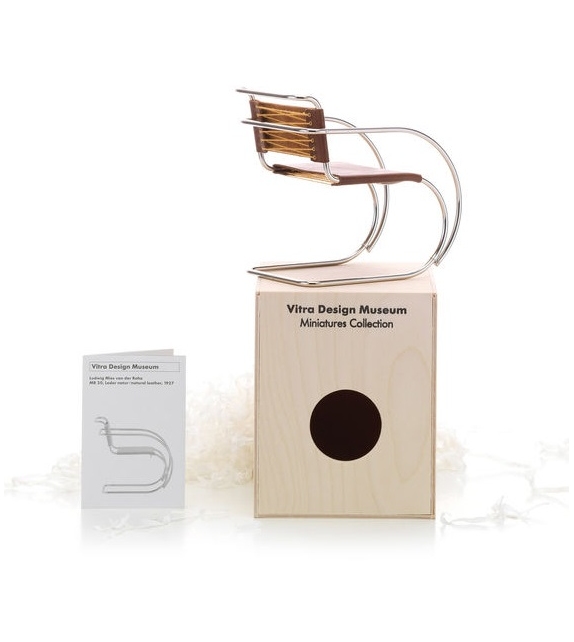The perfect time to take home the design objects you've always wanted. Enjoy our XMAS GIFTS now!
Miniature MR 20, Mies van der Rohe Vitra
202 051 01
New product
Vitra Miniature MR 20, Mies Van Der Rohe: During the mid-twenties, tubular steel won favor among avant-garde designers as a preferred material for furniture design. It was Mies van der Rohe who first discovered the elasticity of steel tubing and utilized it as a structural principle.
Vitra Miniature MR 20, Mies Van Der Rohe: During the mid-twenties, tubular steel won favor among avant-garde designers as a preferred material for furniture design. The most important designs for tubular steel, now regarded as classics of modern furniture design, were created within the course of just a few years. During preparations for the Weissenhof exhibition in Stuttgart, Mart Stam developed a new chair type, the tubular steel chair with no back legs. In order to counter the possible instability of the cantilevered frame, Stam reinforced the steel tubing at critical angles, thereby creating a strong, but rigid structure. It was Mies van der Rohe who first discovered the elasticity of steel tubing and utilized it as a structural principle. Inspired by Stam’s idea, he designed the first flexible cantilevered chair in the history of design in 1927. The model was produced both with and without armrests under the names MR 20 and MR 10, respectively. The tubular steel furniture of the 1920s represents a rejection of the conventional,overladen bourgeois interior of the time, filled with massive furniture and decorative trinkets. The transparency and structural clarity of tubular steel furniture embodies a new ideal in architecture and design: interior space flooded with natural light. Nickel-plated tubular steel, natural leather.
The collection of the Vitra Design Museum en miniature: The Miniatures Collection of the Vitra Design Museum covers the most important pieces from the international history of design from 1850 up to the present. The construction, materials and colours of the miniatures correspond precisely to the historical original. Extensive development work was carried out to adapt the manufacturing techniques to the requirements of miniaturization. Because they are so true to the originals, the miniatures are not only collector’s objects for furniture enthusiasts, but also serve as ideal illustrative material for universities and design schools. At present, the collection encompasses 80 models on a 1:6 scale with further pieces being continually added. The models come in their own wooden box and are accompanied by a descriptive brochure with details on the design. Net proceeds from the sale of the miniatures go towards the exhibitions and workshops of Vitra Design Museum.
Miniaturization means concentration: Vitra Design Museum faithfully replicates furniture design classics in miniaturized three-dimensional form. Many of these designs, like the chaise longue by Le Corbusier or the red-blue chair by Gerrit Rietveld, are as widely known today as the most celebrated works of art and are coveted by museums and collectors the world over. These miniatures illustrate at a glance what design means and what role it plays in the industrial production process. The clear and concentrated world of the miniatures yields a fascinating reflection of the stylistic diversity of contemporary design and provides a unique way of accessing the history of furniture design.
The manufacture of the miniatures: Vitra Design Museum has one of the most renowned collections of industrial furniture design – from the infancy of industrial mass production in the mid-19th century through the designs of functionalistic Modernism up to the postmodern furniture objects of the present day. With its many exhibits, the collection provides us with an ideal base for developing new furniture miniatures. Model builders measure the historical original in the museum collection, scale this down to one sixth of the original size and compile technical documentation. Subsequently, materials and manufacturing techniques are tested over a period of several months: the shapes are formed, materials and processes are selected, art historical research on the objects is conducted and then the production sequences are defined.
100% Original
All the products from Miliashop are original and they are covered by warranty.
| Typology | Collectible items |
| Length | 9 cm |
| Width | 14.5 cm |
| Height | 13 cm |
| Design Year | 1820 - 2011 |
| Designer | Vitra Design Museum |





